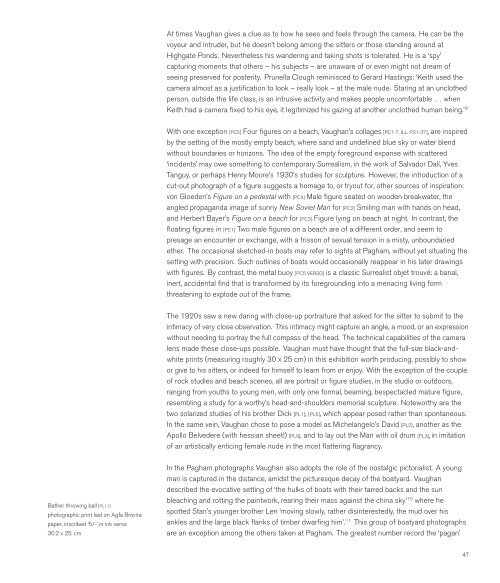Vaughan_book
Create successful ePaper yourself
Turn your PDF publications into a flip-book with our unique Google optimized e-Paper software.
At times <strong>Vaughan</strong> gives a clue as to how he sees and feels through the camera. He can be the<br />
voyeur and intruder, but he doesn’t belong among the sitters or those standing around at<br />
Highgate Ponds. Nevertheless his wandering and taking shots is tolerated. He is a ‘spy’<br />
capturing moments that others – his subjects – are unaware of or even might not dream of<br />
seeing preserved for posterity. Prunella Clough reminisced to Gerard Hastings: ‘Keith used the<br />
camera almost as a justification to look – really look – at the male nude. Staring at an unclothed<br />
person, outside the life class, is an intrusive activity and makes people uncomfortable … when<br />
Keith had a camera fixed to his eye, it legitimized his gazing at another unclothed human being.’ 9<br />
With one exception [PC5] Four figures on a beach, <strong>Vaughan</strong>’s collages [PC1-7, ILL. P.21-27], are inspired<br />
by the setting of the mostly empty beach, where sand and undefined blue sky or water blend<br />
without boundaries or horizons. The idea of the empty foreground expanse with scattered<br />
‘incidents’ may owe something to contemporary Surrealism, in the work of Salvador Dalí, Yves<br />
Tanguy, or perhaps Henry Moore’s 1930’s studies for sculpture. However, the introduction of a<br />
cut-out photograph of a figure suggests a homage to, or tryout for, other sources of inspiration:<br />
von Gloeden’s Figure on a pedestal with [PC4] Male figure seated on wooden breakwater, the<br />
angled propaganda image of sunny New Soviet Man for [PC2] Smiling man with hands on head,<br />
and Herbert Bayer’s Figure on a beach for [PC3] Figure lying on beach at night. In contrast, the<br />
floating figures in [PC1] Two male figures on a beach are of a different order, and seem to<br />
presage an encounter or exchange, with a frisson of sexual tension in a misty, unboundaried<br />
ether. The occasional sketched-in boats may refer to sights at Pagham, without yet situating the<br />
setting with precision. Such outlines of boats would occasionally reappear in his later drawings<br />
with figures. By contrast, the metal buoy [PC5 VERSO] is a classic Surrealist objet trouvé: a banal,<br />
inert, accidental find that is transformed by its foregrounding into a menacing living form<br />
threatening to explode out of the frame.<br />
The 1920s saw a new daring with close-up portraiture that asked for the sitter to submit to the<br />
intimacy of very close observation. This intimacy might capture an angle, a mood, or an expression<br />
without needing to portray the full compass of the head. The technical capabilities of the camera<br />
lens made these close-ups possible. <strong>Vaughan</strong> must have thought that the full-size black-andwhite<br />
prints (measuring roughly 30 x 25 cm) in this exhibition worth producing, possibly to show<br />
or give to his sitters, or indeed for himself to learn from or enjoy. With the exception of the couple<br />
of rock studies and beach scenes, all are portrait or figure studies, in the studio or outdoors,<br />
ranging from youths to young men, with only one formal, beaming, bespectacled mature figure,<br />
resembling a study for a worthy’s head-and-shoulders memorial sculpture. Noteworthy are the<br />
two solarized studies of his brother Dick [PL1], [PL5], which appear posed rather than spontaneous.<br />
In the same vein, <strong>Vaughan</strong> chose to pose a model as Michelangelo’s David [PL2], another as the<br />
Apollo Belvedere (with hessian sheet!) [PL9], and to lay out the Man with oil drum [PL3], in imitation<br />
of an artistically enticing female nude in the most flattering flagrancy.<br />
Bather throwing ball [PL11]<br />
photographic print laid on Agfa Brovira<br />
paper, inscribed ‘5/-’ in ink verso<br />
30.2 x 25. cm<br />
In the Pagham photographs <strong>Vaughan</strong> also adopts the role of the nostalgic pictorialist. A young<br />
man is captured in the distance, amidst the picturesque decay of the boatyard. <strong>Vaughan</strong><br />
described the evocative setting of ‘the hulks of boats with their tarred backs and the sun<br />
bleaching and rotting the paintwork, rearing their mass against the china sky’ 10 where he<br />
spotted Stan’s younger brother Len ‘moving slowly, rather disinterestedly, the mud over his<br />
ankles and the large black flanks of timber dwarfing him’. 11 This group of boatyard photographs<br />
are an exception among the others taken at Pagham. The greatest number record the ‘pagan’<br />
47


